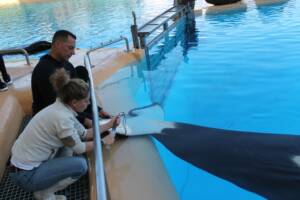A recent study carried out in collaboration with Loro Parque Foundation concluded that contaminants, such as DDT, PCBs and persistent organic pollutants, accumulated in the seas generate together a toxic cocktail that affects the immune system of orcas to a greater extent than if the animals were exposed to the same amount of each substance separately.
The project supported by Loro Parque Foundation in 2017 aimed at investigating how toxic pollutants in the seas specifically affect the immune system of orcas. Dr. Javier Almunia, Director of Environmental Affairs of Loro Parque Foundation, explained that the novelty of this study lies in the fact that the toxic components were measured combined, which is how they are found in nature, and not individually.
The components were selected due to the frequency of their detection in the corpses of the stranded animals in Antarctica. The scientists from the University of Aarhus, Denmark, then implemented the analysis. The study was conducted in a laboratory with the blood extractions, about half a liter each, that were taken from the orcas in the installations of OrcaOcean in Loro Parque. The blood samples were processed to separate the blood cells responsible for the immune system which were subjected to an in vitro test and then exposed to the toxic cocktail.
Dr. Almunia explains that the scientific community has knowledge about how each of these components, for example DDT, affects the immune system of orcas but there is not a lot of research done to analyze the effect produced by a combination of different toxic components. The study concludes that the combined impact is greater, i.e., various of these substances together can cause a major pathogenic effect than each individual component in a similar concentration.
The toxic agents, when combined, start to produce an effect on the immune response capacity in orcas faster than expected. It is also possible that these pollutants influence the reproductive system of the animals, as some of them are similar to hormones in structure. In fact, there is a group of resident orcas in Scotland that has not bred for years, and it is suspected that this has to do with pollution. A toxicology analysis on a female orca stranded recently showed a very high concentration of persistent organic pollutants.
As its greatest impact, this toxic cocktail can shorten the life of the animals as their immune systems are forced to fight constantly against the pathogens, which is something that has already been seen previously in dolphins. Dr. Almunia emphasizes that obviously, “it is difficult to demonstrate that pollution was a direct cause of the death of an animal as, logically, an animal dies eventually as a result of a pathology, an infection, a tumor or a parasite infestation.”
The question that the expert of Loro Parque Foundation raises is how much easier it is for a pathogen to affect the health of an animal whose immune system is depressed. Further extensive studies are needed to answer that, and that is why Loro Parque Foundation is working together with the University of Las Palmas de Gran Canaria, Spain, to identify and analyze the concentration of toxic substances in animals stranded in the Canary Islands.
Up until now, the toxicology has focused on studying each single compound, and this study supported by Loro Parque Foundation helps to bring forth a different perspective which can determine whether toxic compounds, once accumulated in an organism, interact in any particular way among themselves causing, as a result, a greater impact on the immune system in animals.
As far as the regulation and control of these toxic substances is concerned, Dr. Javier Almunia comments that the results of this study are published in the Environmental Science & Technology magazine and are, therefore, available to the scientific community. The next step would be to deliver this information to the political level for the appropriate decisions to be made to address the matter.














